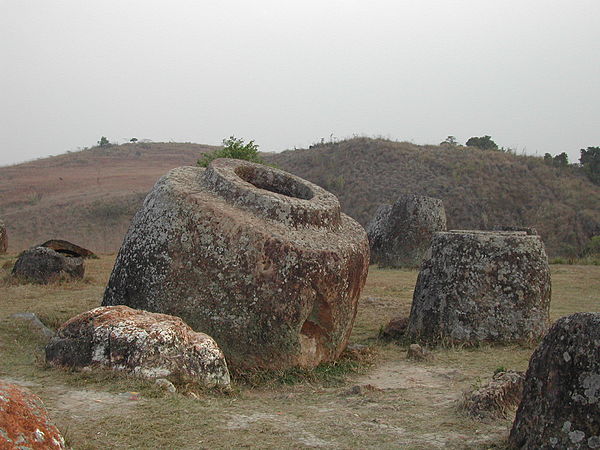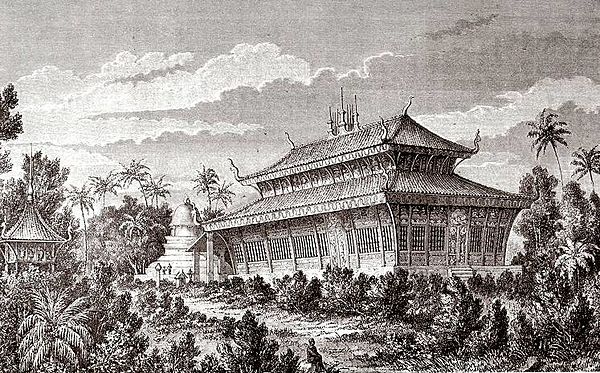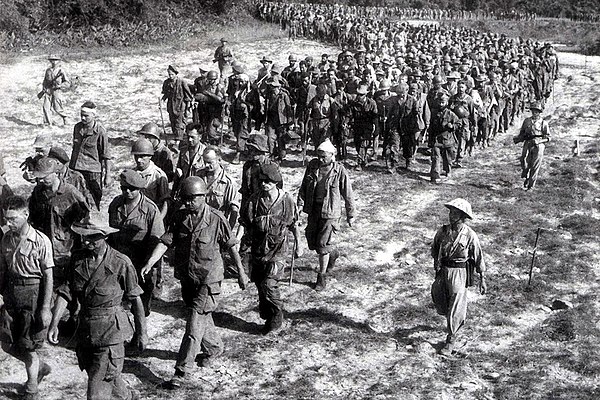In December 1975, there was a sharp change in policy. A joint meeting of the government and the Consultative Council was held, at which Suphānuvong demanded immediate change. There was no resistance. On 2 December the King agreed to abdicate, and Suvannaphūmā resigned. The Lao People's Democratic Republic was proclaimed with Suphānuvong as President. Kaisôn Phomvihān emerged from the shadows to become Prime Minister and the real ruler of the country. Kaisôn immediately began the process of establishing the new republic as a one-party communist state.[54]
No more was heard of elections or political freedoms: non-communist newspapers were closed, and a large-scale purge of the civil service, army and police was launched. Thousands were dispatched for "re-education" in remote parts of the country, where many died and many more were kept for up to ten years. This prompted a renewed flight from the country. Many of the professional and intellectual class, who had initially been willing to work for the new regime, changed their minds and left - a much easier thing to do from Laos than from either Vietnam or Cambodia. By 1977, 10 percent of the population had left the country, including most of the business and educated classes.
The leadership group of the Lao People's Revolutionary Party had hardly changed since the party's foundation, and did not change significantly during its first decade in power. Real power in the party rested with four men: General Secretary Kaisôn, his trusted deputy and economics chief Nuhak Phumsavan (both from humble origins in Savannakhet), planning minister Sālī Vongkhamxao (who died in 1991) and the Army commander and security chief Khamtai Siphandôn. The party's French-educated intellectuals - President Souphanavong and education and propaganda minister Phumi Vongvichit - were more widely seen in public and were Politburo members, but not part of the inner group.
The public policy of the party was to "advance, step by step, to socialism, without going through the stage of capitalist development." This objective made a virtue of necessity: there was no chance of Laos having a "stage of capitalist development" while 90 percent of its population were subsistence farmers, and no chance of an orthodox Marxist path to socialism via a working class revolution in a country which had no industrial working class. The policies of Vietnam led to the economic isolation of Laos from all its neighbours which in turn led to its total dependence on Vietnam.
For Kaisôn the path to socialism lay in emulating first the Vietnamese and then the Soviet models. "Socialist relations of production" must be introduced, and this, in an agricultural country, meant primarily the collectivisation of agriculture. All land was declared to be state property, and individual farms were merged into large-scale "co-operatives." The means of production - which in Laos meant buffalo and wooden ploughs - were to be owned collectively. By the end of 1978 most of the lowland Lao rice-growers had been subjected to collectivisation.
As a result, state food procurements fell sharply, and this, coupled with the cutoff of American aid, postwar cutback of Vietnamese/Soviet aid and the virtual disappearance of imported goods, produced shortages, unemployment and economic hardship in the towns. Matters were made worse in 1979 when the Vietnamese invasion of Cambodia, and subsequent Sino-Vietnamese War, resulted in the Lao government being ordered by Vietnam to break off relations with China, ending another source of foreign assistance and trade.
In mid-1979 the government, apparently at the urging of Soviet advisors who feared that the communist regime was on the point of collapse, announced a sudden reversal of policy. Kaisôn, a lifelong communist, showed himself to be a more flexible leader than many had expected. In a major speech in December, he admitted that Laos was not ready for socialism. Kaisôn's model was not Lenin, however, but China's Deng Xiaoping, who at this time was starting the free-market reforms that laid the foundation for China's subsequent economic growth. Collectivisation was abandoned, and farmers were told that they were free to leave the "co-operative" farms, which virtually all of them promptly did, and to sell their surplus grain on the free market. Other liberalisations followed. Restrictions on internal movement were lifted, and cultural policy relaxed. As in China, however, there was no relaxation of the party's grip on political power.
Laos struck out ahead of Vietnam with its New Economic Mechanism to introduce market mechanisms into its economy.[55] In so doing, Laos has opened the door to rapprochement with Thailand and Russia at some expense to its special dependence on Vietnam.[55] Laos might have reached the same point of normalisation in following Vietnam's economic and diplomatic change, but by moving ahead resolutely and responding to Thai and Russian gestures, Laos has broadened its range of donors, trading partners, and investors independent of Vietnam's attempts to accomplish the same goal.[55] Thus, Vietnam remains in the shadows as a mentor and emergency ally, and the tutelage of Laos has shifted dramatically to development banks and international entrepreneurs.[55]























